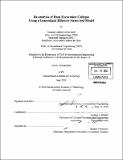| dc.contributor.advisor | Andrew J. Whittle. | en_US |
| dc.contributor.author | Corral Jofré, Gonzalo Andrés | en_US |
| dc.contributor.other | Massachusetts Institute of Technology. Dept. of Civil and Environmental Engineering. | en_US |
| dc.date.accessioned | 2011-01-26T14:19:59Z | |
| dc.date.available | 2011-01-26T14:19:59Z | |
| dc.date.copyright | 2010 | en_US |
| dc.date.issued | 2010 | en_US |
| dc.identifier.uri | http://hdl.handle.net/1721.1/60759 | |
| dc.description | Thesis (Civ. E.)--Massachusetts Institute of Technology, Dept. of Civil and Environmental Engineering, 2010. | en_US |
| dc.description | Cataloged from PDF version of thesis. | en_US |
| dc.description | Includes bibliographical references (p. 137-138). | en_US |
| dc.description.abstract | This thesis re-analyzes the well-documented failure of a 30m deep braced excavation underconsolidated marine clay. Prior analyses of the collapse of the Nicoll Highway have relied on simplified soil models with undrained strength parameters based on empirical correlations and piezocone penetration data. In contrast, the current research simulates the engineering properties of the key Upper and Lower Marine Clay units using a generalized effective stress soil model, MIT-E3, with input parameters calibrated using laboratory test data obtained as part of the post-failure site investigation. The model predictions are evaluated through comparisons with monitoring data and through comparisons with results of prior analyses using the Mohr-Coulomb (MC) model. The MIT-E3 analyses provide a modest improvement in predictions of the measured wall deflections compared to prior MC calculations and give a consistent explanation of the bending failure in the south diaphragm wall and the overloading of the strut-waler connection at the 9th level of strutting. The current analyses do not resolve uncertainties associated with performance of the JGP rafts, movements at the toe of the north-side diaphragm wall or discrepancies with the measured strut loads at level 9. However, they represent a significant advance in predicting excavation performance based directly on results of laboratory tests compared to prior analyses that used generic (i.e., non site-specific) design isotropic strength profiles. | en_US |
| dc.description.statementofresponsibility | by Gonzalo Andrés Corral Jofré. | en_US |
| dc.format.extent | 138 p. | en_US |
| dc.language.iso | eng | en_US |
| dc.publisher | Massachusetts Institute of Technology | en_US |
| dc.rights | M.I.T. theses are protected by
copyright. They may be viewed from this source for any purpose, but
reproduction or distribution in any format is prohibited without written
permission. See provided URL for inquiries about permission. | en_US |
| dc.rights.uri | http://dspace.mit.edu/handle/1721.1/7582 | en_US |
| dc.subject | Civil and Environmental Engineering. | en_US |
| dc.title | Re-analysis of deep excavation collapse using a generalized effective stress soil model | en_US |
| dc.title.alternative | Deep excavation collapse using a generalized effective stress soil model | en_US |
| dc.type | Thesis | en_US |
| dc.description.degree | Civ.E. | en_US |
| dc.contributor.department | Massachusetts Institute of Technology. Department of Civil and Environmental Engineering | |
| dc.identifier.oclc | 691272532 | en_US |
